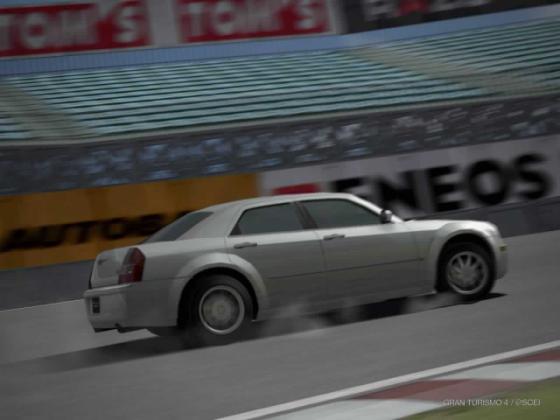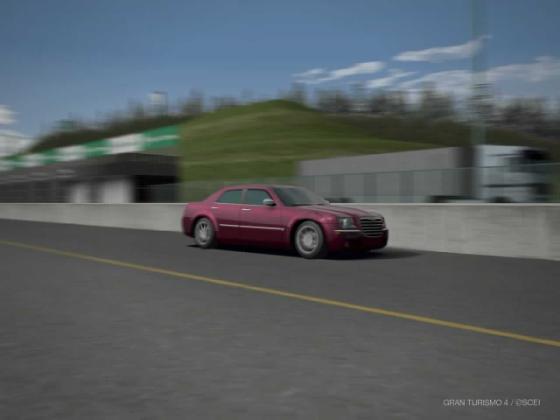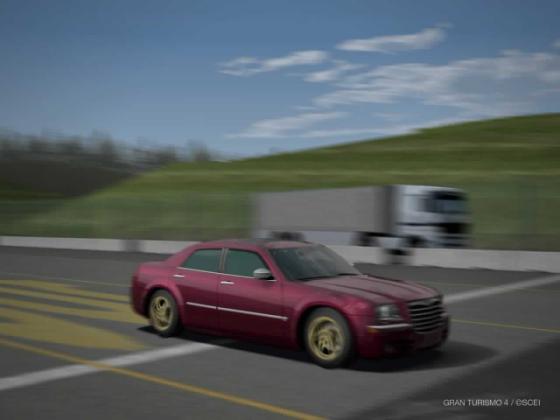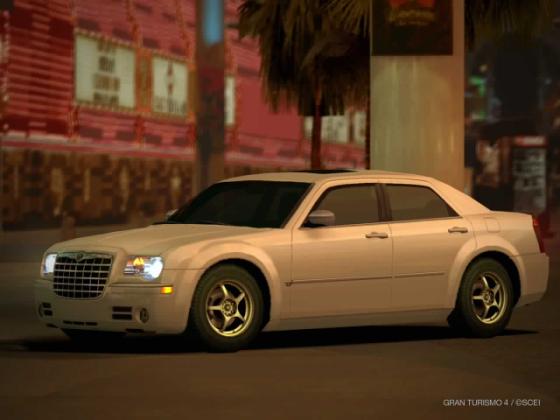|
SPEX
Year: 2005 `````````````````````````````` Body Type:
full-size sedan
Country of Origin: USA `````````````````````` Host: GT4 & GT5
Price: $34,780 (Chrysler New Lot, GT4), $ 32,963 (GT5 used cars)
Length: 196.8" // Width: 74.1" // Height: 53.4"
Wheelbase: 120.0"
Front Overhang: @2 feet
11 inches
Rear Overhang: @3 feet 6.5 inches
Track: 63.0" [F] 63.1" [R]
Ground Clearance: 5.6"
Construction: unit
steel
Weight: 4,139 pounds
Wgt. Dist: 54/46
Steering: power-assist rack & pinion
Turns Lock to Lock: 2.75
Turn Radius: 38.9 feet
Skidpad:
0.79g
Drag Coefficient: 0.355
Layout: front engine / rear drive
Tires: 245/45R-20 [F] /// 255/45R-20 [R]
Brand: 3-season Goodyear
F1 Supercar
F. Suspension: short & long arms, lateral linx, coil-over shocks, anti-roll bar
R. Suspension: multilink,
coils, shocks, anti-roll bar
Brakes: vented discs w/4 piston calipers
Engine: 348 cubic-inch OHV V8
Construction: cast-iron block / aluminum heads
Aspiration:
normal
Fuel System: MPFi
Valves / Cyl: 2
Bore x Stroke: 3.90 x 3.60"
Compression: 10.3:1
GT4 Idle Speed: 750
// Redline: 5,750 // RPM Limit: 6,500
GT5 Idle Speed: 750 // Redline: 5,750 // RPM Limit:
6,000
Final BHP: ```357 @ 5 000 rpms
Fnl.
Torque: 409 @ 4,000 rpms
Credits per HP: $97.42
Pounds per HP: 11.59
HP per Liter: ``62.6
Transmission: 5-speed Automatic
0-60 mph: 5.90 seconds (GT4), 6.069 (GT5)
0-100mph: 13.050 seconds .... 13.678
0-150 mph:
33.xxx seconds .... 37.533
400 M: 14.085 @ 104 mph .. 14.542
@ 103 mph
1 KM: 25.153 @ 135 mph ... 25.692 @ 133 mph
Brakes 100-zero: 4.33 seconds .. 5.200
Test Track Time: 2:16.400 .... .. 56.732 (Daytona)
Top Speed at Redline:
1st: 47 mph
2nd: 81 mph
3rd: 127 mph
4th: 173.3 mph
@ 5,750 rpms
5th: nil (tall-gearing limited)
GT5 4th Gear: 170.2 mph @ 6,000 rpm

--------------------EXTERIOR / HISTORY---------------------
So far as automobiles go, one of America's most striking modern brands on the roads
today is the Chrysler 300. Actually, that's not completely accurate; the 300C in our game is manufactured mostly in Canada,
China, and Austria...it's not from Detroit like a full-size sedan of the past.
In the last 3 years, the 300 has given
Chrysler a much-needed boost in sales. The "full-size" sedan is a vehicle with which this company (along with GM
and Ford) used to have supreme market share, but is now lacking as foreign makes such as Toyota, Nissan and Honda have made
their Camrys, Maximas, and Accords larger and larger. Not to mention Hyundai, Lexus, Infiniti, and Acura's larger sedans.
And then there's the whole SUV phenomenon. ...For all these reasons, Chrysler's larger-car sales (not including minivans and
trucks, of course) had been hit hard, 'til the 300 returned.
Returned? But isn't it a brand-new model
without a history? Most of you might not know this, but the 300-series is nothing new. Way back in 1953, Chrysler created
their first 300. It had a small-block (by today's standards) V8, which could reach 60 mph from zero in 9.8 seconds. It
could also top 130 mph, astounding for a production car of its day. The number "300" stands for 300 horsepower, which is how
much the early Hemi engine was rated at in gross power.
Chrysler's 300s were considered top-line, and were
exceptionally expensive for the time at about $4,109! They were not strong sellers, though. In its first year, Chrysler
only produced 1,725 of these, and in subsequent years, the 300 was typically sold in less numbers, but this didn't seem to
matter because it remained in production for 12 years, and went through several incarnations.
Each year, a letter
was added to the end of the "300" moniker. The original from 1953 was simply called the Chrysler 300, but in 1954, it was
renamed the 300B. 1955 brought us the 300C....and so forth until the 300L ended things in
1965. All told, these so-called "letter cars" eventually were dropped for over a decade as Chrysler tried some new ideas.
In
1979, the "300" name was briefly revived on the Chrysler Cordoba. This was a large, underpowered, fuel-sucking monster that
didn't have a long life as the '80s kicked in, and Japan started to really kick our ass! Despite this, the Cordoba
was an okay (not a great) seller for the short time it was on the market; somewhat on the faux-classy side if I remember
correct.
Fast-forward to 1999. Again, Chrysler brought back the 300....this time, giving it the letter "M" since they
left off with the 300L way back in 1965. M comes after L, get it? Unfortunately, the 300M didn't take back the market as Chrysler
hoped.
As a large, roundish, front-drive, the 300M was regarded by some reviewers
positively. It had a strong V6 engine, rated at 235 horsepower (SAE instead of gross), and this motor was actually
the most powerful 300-series motor to date, since SAE ratings are actually stronger than the old gross-rating system. The
300M also had a sport-rated suspension option, and an aerodynamic profile. Some who drove it found the 300M
unrefined (for the luxury car status Chrysler claimed it should be regarded as), uncoordinated, and average enough to blend
in with most of America's cars of the past decade like the Chrysler Concorde, Dodge Intrepid, Ford Taurus, etc.
Ultimately forgettable it was, and still is. Well, as we know, all that would change.
In 2003, Chrysler presented their
new LX platform at some auto show. For this new 300-series vehicle, they did what Americans have done best in the past: re-introduced
a rear-drive layout optioned with several engines: from the base 2.7-liter V6, to the nearly top-line 5.7 Hemi V8
in our game-car. The new 300 models are nothing like we have seen before, and there were many levels: Base, Touring,
Limited, Base AWD, Touring AWD with available yaw control, etc. With all these choices, a buyer can contemplate according
to how much money he or she has on hand, and what their performance needs are.
Unlike the blandly-shaped 300M, the
new 300C features a regal, oversized grill borrowed from 300C of the '50s. Unfortuantely, it didn't also get the
original 300C's tailfins. :( Can't have it all.... The massive grill on both the original 300C and the modern one is flanked
by 2 sets of headlights located squarely over the driving lights...again, very eye-catching. This car wants to be
noticed. Like a spoiled monarch, it wants attention, and it usualy gets it.
With its blocky dimensions, the 4,139
pound body is the antithesis of the former 300M, which was lighter and had a sleeker shape. BOTH cars are ugly, of course...apparently
Americans demand ugliness; however, the new 300s have something missing from the old 300M.
A bit of class? No, that's
not it. Macho-ness? Yeah, that's closer.
Whatever it is, the new 300-series Chryslers are currently selling
in stronger numbers than before: about 10,000 a month at this writing with occasional waiting-lists depending
where you live. The 300C is sold overseas, too, to those who can actually afford all the gas this giant slurps up. Anyways,
10,000 a month is a far cry from the numbers 300s originally generated (fewer than 2,000 a year back in the '50s
and '60s). The 300 has become one of the "Kings of Bling" as well; its oversized features and stature have made it a status
symbol in the hip hop world, just like Cadillac's Escalade and CTS, and Lincoln's Navigator. This is the sort of thing that
perhaps makes the original designers and engineers of the new 300C cringe, but sales are sales, right?
Well..enough
hypotheticals....let's find out exactly how this giant fits into GT4. And 5. Moderately priced (not cheap in either game,
but also not priced into Benz territory), these can be had easily so far as cost goes. GT5 is going to be the more difficult
find though, since these cars can only be found in the Standard Car lot. They're not too rare, but also not an instant buy
like they were.
In GT5's in-car view, we've got lots of glass to see
through. We can turn our head and get a good look at who's behind us, and the passenger-side mirror is large enough to be
useful for those lurking at those rear quarter panels.
And now for the second item on our gaming agenda:
WTF???!!? This is not a race car! Well, you might be surprised to find that at various
tracks, the 300C (despite its weight, despite its size) actually handles itself with dignity, strength, and generally
gets around with more prowess than I expected. This is not the over-powered, poorly-handling block of wood I predicted
it would be at all...so let's start with the part I did expect.

----------------ENGINE / DRIVETRAIN--------------------
As we approach the local Chrysler dealer, our salesman "Brad" appears to size
me up, and doesn't waste time blabbering on about stuff we don't wanna hear. He doesn't go "got any kids?" or anything
like that; instead, he seems to know who I am and what I want. Perhaps it's my black leather jacket, or my stylish
Ferrari sunglasses. WHATEVER it is, this guy may not be psychic, but he is intuitive.
"Hey, you're that Parsmelly
guy from the ESPN GT series!" he chats up.
"Uh...that's Parnelli".
As we walk towards the showroom, a centerpiece
display featuring a wine-red 300C catches my eye, and I'm stalking next to the car before he can gather up beside me.
"Yep.
It's got a Hemi." he says as we crowd over the open hood and I stifle a laugh. I knew he would say that.
;)
...and I need not hear any more from him. This Chrysler 300C Hemi with its 20-inch wheels is the one I
want. I'm practically drooling to rev that engine.
Actually, the 5.7 liter OHV V8 from our game is
not the largest engine a 300C can possibly be equipped with in real-life. There is also a 6.1 liter. But the 5.7 I'm gazing
at ain't bad at all, and it sounds like a symphony as I bring it to life! It'll eventually have 357 horses
after basic break-in & maintenance is over...and just over 400 foot-pounds of torque. Do I really need
more? Well it doesn't matter. GT4's Hemi is the smaller 5.7, rather than the largest 6.1...but will do just fine for my needs.
At a
long oval test track (located conveniently behind the Dodge/Chrysler dealership), I take my new (I'm already considering
this car to be mine hee hee) 300C for some quick acceleration and speed runs. Despite my na´vetÚ, the Chrysler dealer with
his overbearing manner totally seems to expect nothing less as I pilot this car to the course.
Acceleration
is no problÚmo, se˝or. New 300-series Chryslers all come with traction controls as an option, yet standing-start acceleration
doesn't suffer at all as I turn this system off. Zero to 60 mph in just under 6 seconds. Zero to 100 in just
over 13...and a 14-ish quarter. GT5's car is slightly slower, because for some reason it comes from the dealer with
radial tires instead of sports, but either way, this sort of go-power is sweet! Yes, I know it aint the best; but
after I remove those rear seats and rip up the upholstery, this car will weigh less and be even faster!
In fact,
as I do my high-speed run, I'm pleasantly surprised that my new 300C tops 173 mph (GT4),
completely stock! Despite its non-aerodynamic shape! Not bad! Only problem is: in doing so, it only gets to
4th gear. My new car (there I go again with the "my" car bit) stretches to 170....171....172..and finally 173 miles per
hour...its engine barely reaches redline. Just when I think it will kick over into 5th gear, it simply can't get any
further. Damn!
As I return from the track, Brad is visibly shaken for some reason. Bad burger? Or did his mistress
just show up unannounced at the dealership and thrust some 8x10s in his face in an attempt at blackmail? Huh...I dunno.
For
now, I ignore Brad. I give a call to our rep over at MOPAR. Turns out my pit-crew boss still has some sponsorship deals
to work with them, and to my satisfaction, I find there are 3 levels of tuning available and
a supercharger should I need them in the future! Could this day get any better??!?!
But for a moment, I muse about
my recent high-speed run, in which my car (DAMMIT it's not mine yet!) couldn't break out of 4th gear. Real-life Chrysler 300's
can be equipped with either a 4 or a 5-speed automatic transmission. The gearing is as tall as a skyscraper, though. Great
for the highway (where the engine switches from 8 to 4 cylinders in an effort at better fuel-economy), but not so promising
for some of the tighter, more technical tracks I plan on racing in the near future. Bummer.
Well, I'm not too
worried. Just a single cloud on a sunny day, folks. Even though the gearbox is not exactly what I prefer, at least the
engine's torque is mightier than might, right? No worries.

-----------CHASSIS / HANDLING-------------
Despite my enthusiasm, Brad, the previously pushy dealer, immediately balks when I mention driving my
...I mean HIS...300C out to a small, local track. In defense, he mutters something about insurance premiums, and begins to
look at me like I'm insane. Yeah, well at the moment, maybe I am insane dude, maybe I am.
GT4
But
this doesn't matter. I recently won a slew of "70's Classic" sprint races over in Japan in an old Datsun 280Z-L, so my bank
account is looking healthy. Let's get the paperwork done. I fork over the money in the same amount of time as it takes to
push a few buttons. ;)
As mentioned before, the 300C (as a race car) wasn't what I was expecting. It helps that
the "Daimler" side of Daimler/Chrysler is European-based. Us Americans are great with drivetrain layouts (when they're rear-drive
especially) but the "European" edge this car gets from its Austrian-based location means the 300C also handles its enormous
weight with style, dominance, and even grace. Like a big fullback who manages to dance thru a line of football players, this
car has many surprises under its belt. The previous 300M, built from 1999 till 2004, was known for being a bit rough around
the edges. The new 300C feels more solid.
Those giant low-profile 3-season radials help, as do the beefy independent suspension and 4-caliper vented
disc brakes all around. Anyways, so far as handling this car goes, here's the breakdown.
What I was Expecting:
1.
Lots of understeer.
2. Lots of sliding.
3. Lots of un-polished, SUV-like behaviour.
4. Wallowy suspension.
5.
Difficult steering into corners.
The Reality:
1. Understeer? Yes...but alot less than I
expected. It's at its worst in tight corners, where the 120-inch wheelbase this car sports shows its worse side, but in general,
the understeer is not so bad..especially after I turn off the stability-control system my 300C is equipped with.
2.
Unwanted Sliding? Again, piloting the 300C on N3 tires and a stock suspension around Apricot Hill, I
found this car quite stable with a firm footprint. I'm professional enough nowadays that unwanted slides simply don't happen
to me, and this car happily wants to keep me happy.
.....Still, I couldn't help but push the 300C more severely
with these non-sport radials attached later on in my career, when engine power was raised. At the limit, the 300c will understeer,
"step out" of line with occasional oversteer; yet I still had plenty of command.
3. Un-polished, SUV-like?
Not at all. Matter of fact, at times the 300C drives similar to some larger E-class Benz sedans found in some GT games.
This isn't a total surprise, since the 300C and E-class both share suspension parts.
4. Wallowy suspension?
Well, this heavy car does lean and dive into turns, but with firm coils all around, it still gives lots to work with.
This is no 300M.
5. Difficult steering into corners? At times, yes. But it's just a matter of getting
used to driving a 4,000 pound car around when I've recently been used to a 2,700 pound one.
Mostly, you'll see some
heavier understeer into corners under braking. This car isn't as bad as some earlier "musclecars", but late-braking and trail-braking
are still not something you'll want to try and pursue in the 300C Hemi. It doesn't like these actions so much.
As I
said earlier, understeer does dominate over oversteer, but it doesn't show up immediately if you are careful. This is no ancient-handling
muscle car, after all. The 300C is shod with slightly larger tires in the rear than it has up front, which is an effort to
make sure the 5.7 liter powerplant gets to say what it has to say with minimal backtalk. So it takes awhile (and this means
after Stage 2 power or a supercharger is equipped) before the rear of my 300C starts to take a walk.
GT5
Now for GT5. We can actually use the exact same logic in the previous game now, but with different results.
I drove this car completely stock (cheap soft radial tires and all), then beefed it up and raced in a couple different
series. In this game's Muscle Car Series, and also during the Gran Turismo World Championship.
1. Understeer? Heh heh. As just stated, the first drive in this car was done on its
factory tires. Soft comforts. Yeah. Quite a mess, this one was, on these tires. We never got to see anything like this
during my GT4 days, even when I downgraded the GT4 300C's stock sports to N3s!
My very first turn into the very first corner at Laguna Seca (GT5) resulted into a dramatic, slow-motion
push right off-track and into some sand. And it only got worse from there. Even at really low speeds (somewhere between 40
and 50 mph into the first hairpin, for instance) I could just feel the car slipping ever-so-slightly towards the trap. To
survive in the 300C on THESE tires means to drive..... really .......... slow.
But once the sport tires are on? Just like in GT4, understeer is expected, but not immediately felt.
My first race in a 300C was at the Muscle Car race at Daytona's Road Course. Soft sport tires were chosen. Wide
paths to follow, a couple of tight hairpins, and one wicked dual-chicane. Not much to report, to be honest.
I lost the race; came in 4th place, it was mostly due to a blunder during Lap 3 in between those two final
chicanes. Caught some grass, lost control, regained it, but by then it was over. I had lost momentum, and the Camaro which
I would have caught up to was now dozens of car-lengths ahead up on Daytona's final banked curve.
Granted, the car was raced on soft sport tires, and if we chose lesser shoes, we'd get lesser results,
but other than some brief moments when the car's front was being pushed to its limit, there is no real true pushing.
This also goes for the race at Laguna Seca, although now it's much more possible to take a corner
too hot, then lose all your wiggle room. With a 120 inch wheelbase, again this car will never be a quick-thinking Beemer,
or a quicker-reacting Lotus. Brakes are fantastic in this Crhysler (considering all that weight), so use them.
Otherwise, some understeer does start to show up at a track like this, and it won't go away until we're in a dang sand
trap.
2. Unwanted Sliding? Bingo. Especially while on its factory tires, oh my God. The front may
be difficult, and this is true, but the REAR is 12x more cantankerous. My first drive around Laguna Seca with soft comforts
attached turned into a situation where the 300 got so banged-up (and I had damage turned on), it was useless to try for a
second lap. So that's the stock tires. Then again, adding sport tires doesn't automatically make all this go away.
There are times the Chrysler 300C handles so well with any grade of sports (but softs most of all, of course).
It just feels completely solid, which is a result of the fact that I initially drove the car fully-weighted during the Muscle
Car Series. The 300 shrugs off bumps, picks a line and sticks to it. UNTIL > (heh heh)
....Until one of its rear tires hits a soft spot. Could be an inch of grass, or a jounce upon a
rumble strip. All a sudden, this car loses ALL of its poise, and ALL of its previous grace. This is something which should
have happened in GT4 of course, but ... we all know about GT4 and FR cars, right? Anyways, sometimes you don't even
need to have one of this car's rear tires in a bad spot; sometimes all it takes is a little too much gas on pure pavement.
Now the Hemi's torque is simply overbearing. The car slides wildly from the rear, like a baseball player throwing his weight
onto some slick Astroturf. One of those 'whoa, didn't expect that' moments occurs.
On the other hand, respect this car's girth and its torque, and wait until a more opportune moment to strike
that gas pedal, and now the 300C lifts out of turns (any turns) with so much traction, and so much ease, you might start to
miss those slides after awhile.
The other items
on the above list (SUV like?, Wallowy suspension, and Difficult to steer?) are all the same. Overall the 300 still has some confidence,
and isn't as bad as we might have thought it was. As long as you ditch this car's original tires, that is.
As I leave the dealership, Brad is no longer smiling. Nope, it's not a bad burger, nor has his secret
lover shown up. He's simply JEALOUS. Jealous, because he has apparently been waiting for HIS chance to take flight around
the big Test Course behind the dealership, but insurance won't cover him! In one week, I have the potential to make more
money that poor Brad earns in a year! Ultimately, I'm the big rock-star race driver, while he tends a middle-road dealership
out on Route 40 in between the Kwik-E-Mart and Fat Burger, day in and day out. :)
I sign an autograph anyways.
PROS----------------------------------
1). "It's got a
Hemi." Stomp factor and high speed guaranteed. Great acceleration for a 4,100 pound car...and that 173 mph ceiling calls for
some celebration.
2). It's also got 10" wide, 20" diameter supertires equipped, which (along with a heavy-duty
suspension) keep this heavy car tracked and locked with stability.
3). What a macho 'mobile! Masculine, hulking..like
it means business. It's nice that the modern 300C's face is based on the 300C from 1955, yet isn't totally retro or cheesy
about it.
....A real-life car reviewer over at www.Edmunds.com was having trouble hiding his enthusiasm as he wrote about the new 300C when it first appeared on the market.
I quote: ..."it's too early to tell if this car will become a classic or not...".
4). Not overly expensive
like the Mercedes E-class cars the 300C borrows parts from...and the 300C is worth every credit.
5). Mismatched front
& rear tire sizes. Rear tires are about 10 mm wider. Face it, this is a sports-car move, folks; and will guarantee few
moments of "Hemi-outrage" as you exit corners (in GT4, anyways). Rear-end fishtailing doesn't become an issue till Stage 2
parts are installed. Stage 1 engine parts give just enough power so that the rear "steps out" occasionally, which rocks. GT5's
cars will step out at anytime, especially in 2nd gear. But many see this as more of a Pro than a Con, right?
6). Speaking of which: there are 3 stages of naturally-aspirated tuning and a supercharger to play with.
650+ horses from a Stage 3 system after all is said and done in GT4.
7). Limited-slip devices not
needed till perhaps Stage 2 parts are being used in GT4.
8). That mean-dog growl from the engine & tailpipe. Sounds
like somebody is about to get out my way...or else... 9).
GT5: in-car view gives us lots to work with. Useful mirrors to see around blind spots, and lots of glass.
CONS----------------------------------
1). 4,100+ pounds stock.
2). An unusually
short deck and trunk area (considering this is an American full-size sedan and not a German one), but the long wheelbase ruins
manuverability in tight corners. Not exactly a nimble car for "switchback" areas like esses, slaloms, and hairpins. That firm,
highway handling eventually shows its limits.
3). A criticism of Polyphony Digital...not the 300C itself: WHERE IS
THE DODGE CHARGER? THE MAGNUM? How can you include 40+ Skylines in GT4 (not including hidden models) and not 2 simple variations
of Chrysler's LX-platform?
4). Understeer. Although it doesn't immediately raise its ugly head, it will eventually
show up. Sometimes, a simple mid-corner brake-tap won't get rid of it, forcing me to really slow down. Heavy braking
needed early to avoid all this.
5). Some consider these ugly. Some would say the ugliest product on the American market!
6).
Tall gearing. The close-ratio gearbox is sometimes too short: you'll find yourself redlining down the straight at Apricot
Hill. This is truer in GT4 than 5.
7). The car's profile looks dignified but blocky....and is about as aerodynamic
as a mailbox.
8). Nitrous lovers will be shocked to find this car can't be equipped with an NO▓ system in GT4.
9).
While stock, the rear tires provide lots of grip under heavy acceleration. This changes as Stage 1 parts get installed. Lots
more standing-start wheelspin guaranteed. 10). GT5: 160 miles-per-hour speedometer?
WHY? 11). GT5: cheap tires on this car from the getgo. Even with sport tires, sometimes some advanced
parts (limited-slip, stronger suspensions...) are needed earlier than they were in GT4. Published: March 26, 2008 GT5 Content: August
6th, 2014
|





